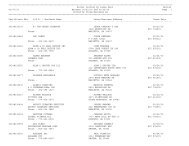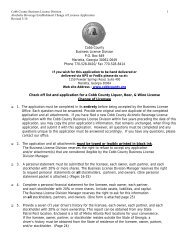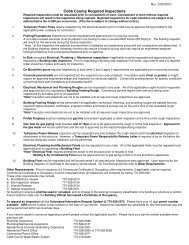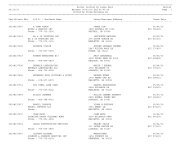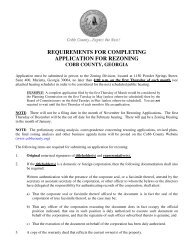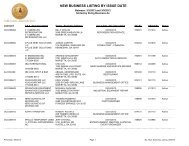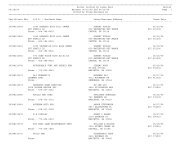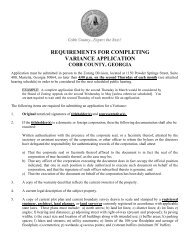State Route 6 Corridor Study Final Report - Cobb County Government
State Route 6 Corridor Study Final Report - Cobb County Government
State Route 6 Corridor Study Final Report - Cobb County Government
You also want an ePaper? Increase the reach of your titles
YUMPU automatically turns print PDFs into web optimized ePapers that Google loves.
Two alternate scenarios were developed to compare against the baseline, a trends<br />
scenario and a corridor assets scenario. The trends scenario assumed that current<br />
growth, development, and personal travel trends will continue through 2030. This<br />
means the predominant mode of transportation in 2030 will still be the single occupant<br />
vehicle (SOV). The transportation focus was to manage the forecasted increase in<br />
commuter traffic and provide congestion mitigation for the critical locations within the<br />
corridor. The trends scenario evaluated whether Segments 1, 3, and 4 should be<br />
widened to six lanes, and Segment 2 should be widened to eight general purpose lanes<br />
or seven lanes, which included a reversible high occupant vehicle (HOV) lane.<br />
The corridor assets scenario focused on the natural and built resources within the<br />
corridor. The purpose of transportation projects in this scenario were to support or<br />
enhance the assets with public preservation or investment. The corridor assets scenario<br />
focused on providing a parallel travel corridor to SR 6 and widening the section of<br />
SR 6/Camp Creek Parkway for capacity addition as well as initiating new local bus<br />
service. The corridor assets projects were carried forward to the recommendations.<br />
2.5.2 Land Use<br />
Three land use concepts were developed to accompany the transportation scenarios: a<br />
regional growth framework, a local growth framework, and a sustainable growth<br />
framework. The regional growth framework was based on the ARC Envision6 Regional<br />
Development Policy for metropolitan Atlanta, which provides a vision to unify the<br />
Atlanta Region. The plan views the region from a macro scale and combines areas with<br />
similar land uses. It does not allocate land uses at the parcel level, but it does form a<br />
strong foundation for planning initiatives at the local level. It helps tie together the<br />
plans of various governments and municipalities and provides a single direction for<br />
growth of the region.<br />
The local growth framework was based on existing future land use policies for the<br />
various jurisdictions in the SR 6 corridor study area. This framework reflected the local<br />
desires of each jurisdiction and indicates preferred land uses at a parcel‐specific level of<br />
detail. Though the Envision6 Regional Development Policy for Atlanta was used as a basis<br />
for future development plans, the existing jurisdictional boundaries are defining edges<br />
for different kinds of developments.<br />
The sustainable growth framework combined both the regional and local land use<br />
plans, while adding components that specifically address the three sustainability<br />
<strong>Final</strong> <strong>Report</strong> 2‐8<br />
January 2008



